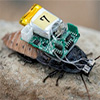| May 13, 2025 |
Researchers unveil a bio-intelligent insect system using UV light to guide movement, reducing harm while improving control.
|
|
(Nanowerk News) In a breakthrough that blends biology and robotics, researchers at The University of Osaka have created a new type of insect cyborg that can navigate autonomously—without wires, surgery, or stress-inducing electrical shocks. The system uses a small ultraviolet (UV) light helmet to steer cockroaches by taking advantage of their natural tendency to avoid bright light, especially in the UV range. This method not only preserves the insect’s sensory organs but also maintains consistent control over time.
|
|
Traditional cyborg insects rely on electrical stimulation, which often involves invasive surgery and can lead to damage of critical sensory organs. Over time, these electrical signals also become less effective as the insect’s body adapts—a phenomenon known as habituation. In contrast, the UOsaka team’s system uses negative phototaxis, a behavior in which insects instinctively move away from UV light. By shining light into either eye, researchers could steer the cockroach left or right, with no need for direct contact with nerves or muscles.
|
|
The team fitted cockroaches with a UV light helmet and a wireless sensor backpack that detects when they stop moving. If motion ceases, UV light is activated to prompt movement. This smart control reduced unnecessary stimulation and saved energy.
|
|
In tests, cyborg insects showed consistent responses over 150 trials without habituation. In a maze-like environment, 94% successfully escaped—compared to just 24% of normal cockroaches.
|
|
According to the research team, this study is the first to demonstrate successful behavior control of insect cyborgs using only their natural sensory system—without any electrical stimulation. The new Bio-Intelligent Cyborg Insect (BCI) model significantly reduces the physical burden on the animal and increases the reliability of movement control in complex environments.
|
|
Keisuke Morishima, who led the study (Advanced Intelligent Systems, “Autonomous Navigation of Bio-Intelligent Cyborg Insect Based on Insect Visual Perception”), emphasized the importance of working with, rather than against, the insect’s natural biology. “Instead of overriding the insect’s brain, we’re guiding it through its own senses. That makes the system safer, more stable, and more sustainable,” he said.
|
|
This gentle, light-based method opens the door to low-burden, bio-hybrid navigation systems with potential applications in fields such as disaster search and rescue, environmental monitoring, and surveillance—especially in places too small or dangerous for conventional robots.
|

